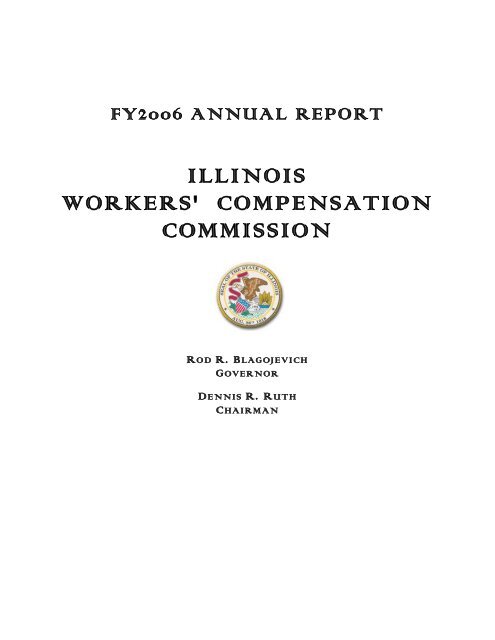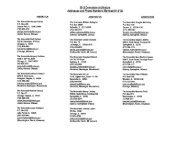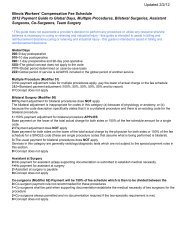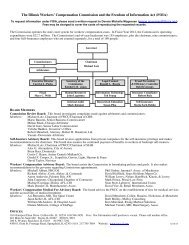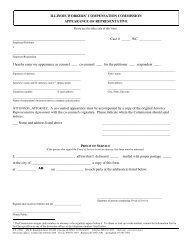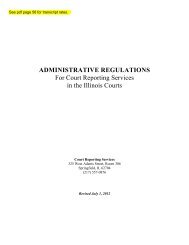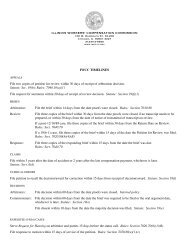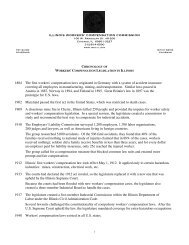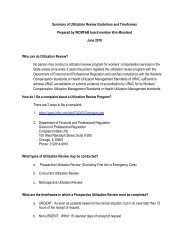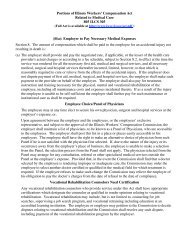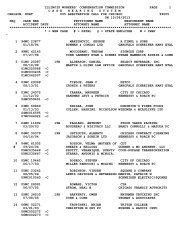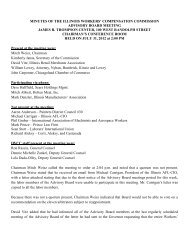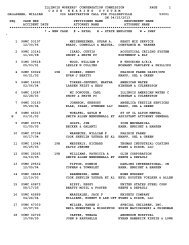illinois workers' compensation commission - IWCC - State of Illinois
illinois workers' compensation commission - IWCC - State of Illinois
illinois workers' compensation commission - IWCC - State of Illinois
Create successful ePaper yourself
Turn your PDF publications into a flip-book with our unique Google optimized e-Paper software.
FY2006 ANNUAL REPORT<br />
ILLINOIS<br />
WORKERS' COMPENSATION<br />
COMMISSION<br />
ROD R. BLAGOJEVICH<br />
GOVERNOR<br />
DENNIS R. RUTH<br />
CHAIRMAN
TABLE OF CONTENTS<br />
LETTER .......................................................................... 1<br />
HIGHLIGHTS .................................................................. 2<br />
MISSION STATEMENT .................................................. 2<br />
BOARD MEMBERS ........................................................ 3<br />
OVERVIEW OF<br />
WORKERS' COMPENSATION ....................................... 4<br />
OVERVIEW OF<br />
DISPUTE RESOLUTION PROCESS ............................... 5<br />
FINANCES ...................................................................... 6<br />
INSURANCE ................................................................... 8<br />
ADMINISTRATION ........................................................ 10<br />
STATISTICS .................................................................. 13<br />
INTERSTATE COMPARISONS .................................... 23<br />
COMMISSION OFFICES<br />
100 W. Randolph #8-200 202 N.E. Madison Ave. #201 701 S. Second St.<br />
Chicago, IL 60601 Peoria, IL 61602 Springfield, IL 62704<br />
312/814-6611 309/671-3019 217/785-7087<br />
1014 Eastport Plaza Drive 200 S. Wyman<br />
Collinsville, IL 62234 Rockford, IL 61101<br />
618/346-3450 815/987-7292<br />
Toll-free: 866/352-3033<br />
TDD: 312/814-2959<br />
Web site: www.iwcc.il.gov<br />
E-Mail: infoquestions.wcc@<strong>illinois</strong>.gov<br />
Note: On January 1, 2005, the <strong>Illinois</strong> Industrial Commission changed its name to the <strong>Illinois</strong> Workers' Compensation Commission.<br />
This report was printed by the authority <strong>of</strong> the <strong>State</strong> <strong>of</strong> <strong>Illinois</strong>: 250 copies were printed with soy ink on recycled paper at a cost <strong>of</strong> $3.86 per copy,<br />
July 2007, no printing order #.
HIGHLIGHTS<br />
• During FY06, we worked to implement the most comprehensive changes to the Workers’ Compensation<br />
Act in nearly 30 years. This bill, agreed to by business and labor leaders through negotiations sponsored<br />
by the governor, established a medical fee schedule; regulated utilization review <strong>of</strong> medical treatment;<br />
increased benefits for widows, orphans, and the lowest-paid workers; created a workers’ <strong>compensation</strong><br />
fraud law and investigatory unit; and improved procedures for cases litigated before the Commission.<br />
• Pursuant to the reform legislation, Governor Blagojevich appointed three more <strong>commission</strong>ers to move<br />
cases at the review level.<br />
• Arbitrators decided more cases in FY06 than any year in the past decade.<br />
• The Commission hired a former prosecutor to run the Insurance Compliance Division, which then<br />
collected over $150,000 from uninsured employers, and brought nearly 500 employees under the<br />
protection <strong>of</strong> the law. (Note: In FY07, we collected over $1 million in penalties.)<br />
• The perception <strong>of</strong> workers’ <strong>compensation</strong> costs is <strong>of</strong>ten different than the reality. Among the 50 states and<br />
the District <strong>of</strong> Columbia, <strong>Illinois</strong> is ranked:<br />
10 th lowest in w.c. injury rate;<br />
25 th lowest in w.c. benefit cost rates (w.c. benefits divided by payroll);<br />
26 th lowest in w.c. medical costs per claim;<br />
30 th lowest in w.c. insurance premium rates;<br />
30 th lowest in w.c. indemnity costs per claim; and<br />
43 rd lowest in wages.<br />
• Accident rates have fallen dramatically. <strong>Illinois</strong>' 2003 workers’ <strong>compensation</strong> total injury rate was<br />
53% lower than in 1991. Everyone wins when injuries are avoided.<br />
• After adjusting for inflation, the 2007 advisory rate for workers’ <strong>compensation</strong> insurance in <strong>Illinois</strong><br />
represents a 34% decrease since 1990.<br />
MISSION STATEMENT<br />
The <strong>Illinois</strong> Workers’ Compensation Commission resolves disputes that occur between injured workers and<br />
their employers regarding <strong>workers'</strong> <strong>compensation</strong>. The Commission strives to assure financial protection to<br />
injured workers and their dependents at a reasonable cost to employers.<br />
The Commission performs four main functions:<br />
1) Resolve disputes. The Commission strives to provide a fair, timely process by which disputed claims<br />
may be resolved.<br />
2) Ensure compliance with the law. The Commission protects the rights <strong>of</strong> employees and employers under<br />
the <strong>Illinois</strong> Workers' Compensation and Occupational Diseases Acts.<br />
3) Administer self-insurance. The Commission evaluates and approves eligible employers that wish to<br />
insure themselves for their <strong>workers'</strong> <strong>compensation</strong> liabilities.<br />
4) Collect statistics. The Commission compiles information on work-related injuries and diseases.<br />
The Commission intends to accomplish these goals while looking constantly for ways to improve the quality<br />
<strong>of</strong> service and treating the public and co-workers with respect. The success <strong>of</strong> this organization depends on<br />
the commitment and full participation <strong>of</strong> every member.<br />
2
BOARD MEMBERS<br />
We are grateful to the individuals who serve on our boards. All serve without <strong>compensation</strong>.<br />
COMMISSION REVIEW BOARD<br />
The board investigates complaints made against arbitrators and <strong>commission</strong>ers. The governor appoints two<br />
public members, the senior labor and business <strong>commission</strong>ers serve by statute, and the arbitrators elect one<br />
Chicago and one Downstate arbitrator.<br />
Robert Hanaford<br />
Attorney, Robert H. Hanaford<br />
Ann Marie Walsh<br />
Attorney, Lord, Bissell & Brook<br />
Mario Basurto<br />
Senior Business Commissioner<br />
Barbara A. Sherman<br />
Senior Labor Commissioner<br />
Edward Lee<br />
Chicago Arbitrator<br />
Ruth White<br />
Downstate Arbitrator<br />
SELF-INSURERS ADVISORY BOARD<br />
The board reviews applications from private companies for the self-insurance privilege and makes<br />
recommendations to the chairman. The board also ensures the continued payment <strong>of</strong> benefits to workers <strong>of</strong><br />
bankrupt self-insurers.<br />
Alex G. Alexandrou<br />
City <strong>of</strong> Aurora<br />
Curtis C. Beam<br />
Archer Daniels Midland Co.<br />
Margaret Blackshere (Public member)<br />
<strong>Illinois</strong> <strong>State</strong> AFL-CIO (ret.)<br />
Gerald F. Cooper<br />
Scopelitis, Garvin, Light & Hanson<br />
Paul M. McCloskey<br />
Amalgamated Bank <strong>of</strong> Chicago<br />
David Taylor<br />
Intl. Truck & Engine Corp.<br />
WORKERS’ COMPENSATION ADVISORY BOARD<br />
The board assists the Commission in formulating policies, setting priorities, and developing administrative<br />
goals. The board also makes recommendations to the governor regarding Commission appointments.<br />
Michael Carrigan<br />
<strong>Illinois</strong> AFL-CIO<br />
Frank Cavarretta<br />
United Steel Workers<br />
Elwood Flowers<br />
Amalg. Transit Union<br />
EMPLOYEES<br />
Dave Menchetti<br />
Cullen, Haskins,<br />
Nicholson and Menchetti<br />
Kim Presbrey<br />
Presbrey & Assoc.<br />
David Buckman<br />
CORE Construction Group<br />
Mark Flannery<br />
Caterpillar, Inc.<br />
Kim Maisch<br />
Natl. Fed. <strong>of</strong> Ind. Business<br />
EMPLOYERS<br />
Boro Reljic<br />
Abbott Industries<br />
Gerald Roper<br />
Chgo. Chamber <strong>of</strong> Comm.<br />
David Vite<br />
IL Retail Merchants Assoc.<br />
WORKERS’ COMPENSATION MEDICAL FEE ADVISORY BOARD<br />
The board advises the <strong>IWCC</strong> on the establishment <strong>of</strong> medical fees and the accessibility <strong>of</strong> treatment.<br />
EMPLOYEES<br />
Eric Dean<br />
Intl. Assoc. <strong>of</strong> Ironworkers<br />
Roger Poole<br />
International Assoc. <strong>of</strong> Machinists<br />
Ronald Powell<br />
United Food & Commercial Workers<br />
EMPLOYERS<br />
Maddy Bowling<br />
Maddy Bowling & Associates<br />
John Smolk<br />
United Airlines<br />
Kathryn Tazic<br />
Sedgwick Claims Mgmt.<br />
MEDICAL PROVIDERS<br />
Elena Butkus<br />
<strong>Illinois</strong> Hospital Assoc.<br />
Jesse Butler, MD<br />
<strong>Illinois</strong> Bone and Joint Institute<br />
Edward Sclamberg, MD<br />
<strong>Illinois</strong> Bone and Joint Institute<br />
3
OVERVIEW OF<br />
WORKERS' COMPENSATION<br />
Workers' <strong>compensation</strong> laws were the first acts <strong>of</strong> social legislation passed in the United <strong>State</strong>s, and they<br />
have always been controversial. At the beginning <strong>of</strong> the 20th century, employers feared the assumption <strong>of</strong><br />
liability for work-related injuries would destroy their businesses, while workers feared financial ruin from<br />
disabling injuries.<br />
Before the laws took effect, an injured worker seeking <strong>compensation</strong> had to file a lawsuit against his or her<br />
employer in court. At the time, the common law held that the employer had a duty to provide a safe place to<br />
work and safe tools; to give warnings <strong>of</strong> dangers; and to provide a sufficient number <strong>of</strong> appropriate fellow<br />
servants to perform the tasks.<br />
In court, the employee had to prove negligence. The employer could present a defense that blamed the<br />
injured worker's contributory negligence, or attributed the injury to the negligence <strong>of</strong> a fellow servant, or<br />
argued that the employee assumed certain risks in accepting the job. The process was prolonged and<br />
uncertain, with large risks to both employee and employer.<br />
The high injury and death rates throughout the Industrial Revolution and growing dissatisfaction with the<br />
common law gradually led to the enactment <strong>of</strong> employer liability acts. Employers were held more<br />
responsible for negligence, but employees still had to file lawsuits for damages.<br />
The first <strong>workers'</strong> <strong>compensation</strong> laws originated in Germany in 1884 with a compulsory system <strong>of</strong> accident<br />
insurance covering all employees in manufacturing, mining, and transportation. Similar laws passed in other<br />
European countries.<br />
In the U.S., laws were passed on a state-by-state basis. Most <strong>of</strong> the early laws covered only hazardous<br />
occupations and were frequently challenged as unconstitutional. Maryland passed the first act in 1902,<br />
which was restricted to fatal cases. The first law <strong>of</strong> general application that withstood legal challenges was<br />
Wisconsin's act <strong>of</strong> 1911. <strong>Illinois</strong> passed its law in 1911, effective May 1, 1912. It took until 1948 for all<br />
states to establish a <strong>workers'</strong> <strong>compensation</strong> law.<br />
Workers' <strong>compensation</strong> laws contain two trade<strong>of</strong>fs:<br />
1. Employees gave up their right to sue and potentially win large awards in court in exchange for more<br />
modest but prompt <strong>compensation</strong>;<br />
2. Employers gave up their common law defenses in exchange for limits on their liabilities.<br />
Workers' <strong>compensation</strong> was established as a no-fault system. The theory behind the law is that the cost <strong>of</strong><br />
work-related injuries or illnesses should be part <strong>of</strong> the cost <strong>of</strong> the product or service.<br />
Originally, the courts administered the <strong>Illinois</strong> act. The volume overwhelmed the courts, however, and on<br />
July 1, 1913, a three-member Industrial Board was created. In 1917, a five-member Industrial Commission<br />
was created within the <strong>Illinois</strong> Department <strong>of</strong> Labor. In 1957, the Commission separated from the<br />
Department <strong>of</strong> Labor and became a self-standing agency. On January 1, 2005, the agency <strong>of</strong>ficially became<br />
the <strong>Illinois</strong> Workers’ Compensation Commission.<br />
Almost every employee who is hired, injured, or whose employment is localized in <strong>Illinois</strong> is covered by<br />
<strong>workers'</strong> <strong>compensation</strong>. For the most part, benefits are paid for accidental injuries that are caused, in whole<br />
or in part, by the employee's work. This includes the aggravation <strong>of</strong> a pre-existing condition and injuries<br />
brought on by the repetitive use <strong>of</strong> a part <strong>of</strong> the body.<br />
<strong>Illinois</strong> employers pay for <strong>workers'</strong> <strong>compensation</strong> benefits through insurance policies or by self-insurance.<br />
Benefits are based on the worker's earnings, subject to certain limits. Cases are first heard by arbitrators,<br />
whose decisions may be appealed to <strong>commission</strong>ers. Cases may proceed on to the circuit court, <strong>Illinois</strong><br />
Appellate Court, and the <strong>Illinois</strong> Supreme Court. Most cases, however, are settled between the parties.<br />
4
OVERVIEW OF DISPUTE RESOLUTION PROCESS<br />
Employee reports injury<br />
to employer<br />
250,000/year<br />
Employer reports<br />
to Commission injuries<br />
<strong>of</strong> more than 3 lost workdays<br />
80,000/year<br />
Commission mails<br />
handbook to employee<br />
Parties resolve case<br />
Parties do not<br />
resolve case<br />
Employee files claim<br />
at Commission<br />
60,000 - 70,000/year<br />
Arbitrator settles case Arbitrator issues decision Arbitrator dismisses case<br />
50,000 - 60,000/year 3,000 - 4,000/year 7,000 - 8,000/year<br />
Decision appealed<br />
to <strong>commission</strong>er<br />
50% appealed<br />
Commissioner settles case Commissioner issues decision Commissioner dismisses case<br />
300 - 600/year 1,000 - 1,100/year 100/yr.<br />
Decision appealed<br />
to Circuit Court<br />
30% appealed<br />
Circuit Ct. issues decision<br />
250 - 300/year<br />
Decision appealed<br />
to Appellate Court<br />
Appellate Ct. issues opinion/order<br />
100/year<br />
Opinion appealed<br />
to Supreme Court<br />
5% appealed<br />
Supreme Ct. issues opinion<br />
1 - 5/year<br />
Note: Cases can go back and forth between levels. Figures reflect the past five years, and are rough estimates.<br />
5
FINANCES<br />
In 2003, the legislature and governor authorized an independent source <strong>of</strong> operating funds for the<br />
Commission. <strong>Illinois</strong> became the 46 th state in the country to pay for its workers’ <strong>compensation</strong> agency<br />
through an independent source <strong>of</strong> funds.<br />
SPECIAL FUNDS<br />
The Commission operates eight funds that are independent <strong>of</strong> the General Revenue Fund.<br />
ACTIVITY OF SPECIAL FUNDS<br />
6/30/05 plus minus plus/minus 6/30/06<br />
Balance Income Expenditures Adjustments Balance<br />
<strong>IWCC</strong> Operations Fund $4,247,068 $18,190,973 $15,916,971 ($3,148) $6,517,922<br />
Injured Workers’ Benefit Fund $0 $159,467 $0 $159,467<br />
Rate Adjustment Fund ($15,924,302) $12,099,357 $11,184,046 $751 ($15,008,240)<br />
Second Injury Fund $523,931 $1,474,395 $1,465,583 $532,743<br />
Self-Insurers<br />
Administration Fund $473,185 $366,331 $175,860 ($256,423) $407,233<br />
Self-Insurers<br />
Security Fund $21,058,586 $5,185,636 $6,860,402 ($1,140,566) $18,243,254<br />
Transcript Deposit Fund $30,496 $11,340 $7,700 $34,136<br />
Workers' Compensation<br />
Benefit Trust Fund $199,426 $1,886 $0 ($199,931) $1,381<br />
<strong>IWCC</strong> OPERATIONS FUND <strong>Illinois</strong> Compiled Statutes, Ch. 820, Para. 305, Sec. 4d; Ch. 215, Para. 5, Sec. 416<br />
The <strong>IWCC</strong> Operations Fund was created in 2003 to pay for the administrative costs <strong>of</strong> the agency. Each<br />
year, employers pay a 1.01% surcharge on workers’ <strong>compensation</strong> insurance premiums, while self-insured<br />
employers pay an assessment <strong>of</strong> 0.0075% <strong>of</strong> payroll.<br />
INJURED WORKERS’ BENEFIT FUND<br />
<strong>Illinois</strong> Compiled Statutes, Chapter 820, Section 4(d)<br />
The Injured Workers’ Benefit Fund was created as part <strong>of</strong> the 2005 legislative reform package. The IWBF<br />
collects fines from uninsured employers and pays benefits to the injured employees <strong>of</strong> uninsured employers<br />
whose employers fail to pay.<br />
RATE ADJUSTMENT FUND <strong>Illinois</strong> Compiled Statutes, Chapter 820, Paragraph 305, Sections 7-8<br />
The Rate Adjustment Fund was created in 1975 to pay cost-<strong>of</strong>-living increases to roughly 1,200 individuals<br />
who are either permanently and totally disabled or the survivors <strong>of</strong> fatally injured workers. Individuals who<br />
receive awards or settlements for permanent and total disability or death benefits are eligible.<br />
Benefits are paid each month, beginning on July 15 <strong>of</strong> the second year after the award or settlement is<br />
entered by the Commission. Recipients are given an amount equal to the percentage increase in the<br />
statewide average weekly wage, as calculated by the Department <strong>of</strong> Employment Security. If there is a<br />
decrease in the statewide average weekly wage, there is no change in the <strong>compensation</strong> rate.<br />
6
The fund has run a deficit since 1994. The assessment amount has been increased several times over the<br />
years, but it has never been enough to cover the benefits paid out.<br />
As provided in the 2005 reform legislation, self-insured employers and insurance companies semiannually<br />
pay 1.25% <strong>of</strong> all indemnity payments paid in the six-month period preceding the payment date. This rate<br />
should guarantee that the Commission will pay benefits on time and pay <strong>of</strong>f the debt over the next several<br />
years.<br />
SECOND INJURY FUND <strong>Illinois</strong> Compiled Statutes, Chapter 820, Paragraph 305, Sections 7-8<br />
The Second Injury Fund provides an incentive to employers to hire disabled workers. <strong>Illinois</strong>' SIF is more<br />
narrowly constructed than most other states. If a worker who had previously incurred the complete loss <strong>of</strong> a<br />
member or the use <strong>of</strong> a member (one hand, arm, foot, leg, or eye) is injured on the job and suffers the<br />
complete loss <strong>of</strong> another member so that he or she is permanently and totally disabled (PTD), the employer is<br />
liable only for the injury due to the second accident. The fund pays the amount necessary to provide the<br />
worker with a PTD benefit.<br />
Approximately 100 individuals receive SIF benefits. In January and July each year, insurers and self-insured<br />
employers pay assessments up to 1/8 <strong>of</strong> 1% <strong>of</strong> <strong>compensation</strong> payments made during the previous six months.<br />
SELF-INSURERS ADMINISTRATION FUND<br />
<strong>Illinois</strong> Compiled Statutes, Chapter 820, Paragraph 305, Section 4a-6.1<br />
The Self-Insurers Administration Fund was created in 1988 to pay the administrative costs <strong>of</strong> the<br />
Commission's self-insurance program. Private self-insured employers pay a fee <strong>of</strong> $500 per entity when<br />
applying for or renewing the self-insurance privilege.<br />
SELF-INSURERS SECURITY FUND <strong>Illinois</strong> Compiled Statutes, Chapter 820, Paragraph 305, Section 4a-5, 6<br />
The Self-Insurers Security Fund was created in 1986 to pay benefits to employees <strong>of</strong> private self-insurers that<br />
became insolvent after 1986. Self-insured employers pay assessments based on their indemnity payments,<br />
up to a maximum <strong>of</strong> 1.2% <strong>of</strong> indemnity benefits paid during the preceding year. The “income received”<br />
column also reflects the collection <strong>of</strong> bonds and escrows from self-insured employers during the year. The<br />
“adjustments” column reflects changes in the unpaid liability <strong>of</strong> the fund. This fund has always paid the<br />
benefits in full.<br />
TRANSCRIPT DEPOSIT FUND <strong>Illinois</strong> Compiled Statutes, Chapter 30, Paragraph 105<br />
When a case is appealed to the circuit court, the appealing party pays a $35 fee for the preparation <strong>of</strong> the file.<br />
W.C. BENEFIT TRUST FUND <strong>Illinois</strong> Compiled Statutes, Chapter 30, Paragraph 105<br />
The Workers' Compensation Benefit Trust Fund pays benefits to employees <strong>of</strong> private self-insurers that<br />
became insolvent before 1986. Benefits are paid from securities posted by the self-insurers; any unused<br />
funds are then returned to the insolvent estate.<br />
7
INSURANCE<br />
Employers are responsible for the payment <strong>of</strong> benefits to injured workers; they must either purchase<br />
insurance or obtain permission to self-insure.<br />
INSURANCE<br />
The <strong>workers'</strong> <strong>compensation</strong> insurance business in <strong>Illinois</strong> is pr<strong>of</strong>itable and highly competitive. More<br />
insurance companies sell <strong>workers'</strong> <strong>compensation</strong> policies in <strong>Illinois</strong> than in any other state. 1 And, over the<br />
last 10 years, the number <strong>of</strong> companies selling w.c policies in <strong>Illinois</strong> actually increased 10%. 2<br />
The National Council on Compensation Insurance, a private organization, issues advisory insurance rates.<br />
<strong>Illinois</strong> carriers are free to set their own rates, and use the advisory rate in their calculations.<br />
Using the NCCI advisory rates, a premium <strong>of</strong> $100 in 1990 would cost only $104.32 in 2007. After<br />
adjusting for inflation, the 2007 advisory rate actually represents a 34% decrease in costs. 3<br />
INSURANCE COMPLIANCE PROGRAM<br />
<strong>Illinois</strong> law requires employers to insure themselves for their <strong>workers'</strong> <strong>compensation</strong> liabilities, but some<br />
employers fail to comply. These employers enjoy an unfair competitive advantage over law-abiding<br />
companies, while leaving their employees vulnerable if accidents should occur.<br />
If the Commission finds an employer knowingly and willfully failed to obtain insurance, it may be fined up<br />
to $500 for every day <strong>of</strong> noncompliance, with a minimum fine <strong>of</strong> $10,000. Corporate <strong>of</strong>ficers may be held<br />
personally liable if the company fails to pay the fine.<br />
Under legislation that took effect July 20, 2005, an employer may also face criminal charges and/or a workstop<br />
order for failing to obtain <strong>workers'</strong> <strong>compensation</strong> insurance.<br />
In FY06, the Commission hired a former prosecutor to run the Insurance Compliance Division. The unit<br />
brought 31 employers, with 467 employees, into compliance, and collected $156,467 from employers found<br />
to be operating without insurance. (Note: In FY07, we collected over $1 million in penalties.)<br />
Pursuant to the 2005 reform legislation, fines are deposited into the newly created Injured Workers’ Benefit<br />
Fund, which then pays benefits to injured workers whose uninsured employers fail to pay.<br />
BALANCE BILLING<br />
By law, employers are responsible for the payment <strong>of</strong> all medical services reasonably necessary to cure or<br />
relieve the injured worker from the effects <strong>of</strong> the injury. In some cases, however, the medical provider or<br />
insurer will try to get the injured worker to pay any unpaid balances <strong>of</strong> medical bills. Workers may be<br />
pursued by collection agencies, and their credit records may be damaged, for bills that were never their<br />
responsibility.<br />
The legislation that took effect July 20, 2005 contains a balance billing provision. If an employee informs<br />
the medical provider that a claim is on file at the Commission, the provider must cease all efforts to collect<br />
payment from the employee. Any statute <strong>of</strong> limitations applicable to the provider's efforts to collect from the<br />
employee is tolled from the date that the employee files the application with the Commission until the date<br />
that the provider is permitted to resume collection.<br />
When an employee notifies a medical provider that the treatment or service is for a work-related injury, the<br />
provider shall bill the employer directly. If the employer does not dispute payment <strong>of</strong> first aid, medical,<br />
surgical, or hospital services, Section 8(a) provides that the employer shall make payment directly to the<br />
provider on behalf <strong>of</strong> the employee. The employer shall pay the bill within 60 days <strong>of</strong> receipt <strong>of</strong> the bill as<br />
long as the claim contains substantially all the required data elements necessary to adjudicate the bills.<br />
8
Unpaid bills incur interest at a rate <strong>of</strong> 1% per month, payable to the provider. A provider cannot hold an<br />
employee liable for costs related to non-disputed services for a compensable injury and shall not bill or<br />
attempt to recover from the employee the difference between the provider's charge and the amount paid by<br />
the employer or insurer on a compensable injury.<br />
While the claim at the Commission is pending, the provider may mail the employee reminders that the<br />
employee will be responsible for payment <strong>of</strong> the bill when the provider is able to resume collection efforts.<br />
The provider may request information about the Commission claim and if the employee fails to respond or<br />
provide the information within 90 days, the provider is entitled to resume collection efforts and the employee<br />
is responsible for payment <strong>of</strong> the bills. The reminders shall not be provided to any credit agency.<br />
SELF-INSURANCE<br />
Private employers may obtain approval to insure themselves for their <strong>workers'</strong> <strong>compensation</strong> liabilities, or<br />
they may join a pool <strong>of</strong> other employers. The Commission evaluates individual self-insurers, while the<br />
<strong>Illinois</strong> Division <strong>of</strong> Insurance evaluates pools. Public employers may self-insure without obtaining approval.<br />
Less than 1% <strong>of</strong> employers self-insure, but they are among the largest organizations in the state, and employ<br />
roughly 10% <strong>of</strong> the employees in <strong>Illinois</strong>.<br />
As the cost <strong>of</strong> traditional insurance has decreased, many employers have stopped self-insuring and returned<br />
to conventional insurance arrangements.<br />
PARENT COMPANIES<br />
PARTICIPATING IN THE<br />
COMMISSION'S SELF-INSURANCE PROGRAM<br />
Date<br />
# Parent Companies<br />
6/30/95 496<br />
6/30/00 361<br />
6/30/01 335<br />
6/30/02 329<br />
6/30/03 314<br />
6/30/04 317<br />
6/30/05 319<br />
6/30/06 311<br />
9
ADMINISTRATION<br />
ADMINISTRATIVE ACCOMPLISHMENTS<br />
• In FY06, arbitrators issued the most decisions since FY93.<br />
• The chairman directed arbitrators to give special attention to the oldest cases and make more efforts to<br />
resolve these cases. Since that directive, the number <strong>of</strong> red-line cases—those three years old or older—has<br />
dropped by 9%.<br />
• The total number <strong>of</strong> cases pending at the Commission has declined from over 111,000 cases in FY03, when<br />
the Blagojevich administration took <strong>of</strong>fice, to less than 100,000 cases at the end <strong>of</strong> FY06.<br />
• The Commission hired a former prosecutor to run the Insurance Compliance Division, which then<br />
collected over $150,000 from uninsured employers, and brought nearly 500 employees under the<br />
protection <strong>of</strong> the law. (Note: In FY07, we collected over $1 million in penalties.)<br />
• The Commission implemented the first medical fee schedule in <strong>Illinois</strong>. The schedule is the first in the<br />
country to be <strong>of</strong>fered completely online.<br />
• The Commission expanded its web page, adding a page that allows users to check the status <strong>of</strong> all w.c.<br />
cases, and another page that allows users to check employers’ w.c. insurance coverage. Previously, an<br />
individual would have to either call or come to the <strong>of</strong>fice to obtain this information.<br />
• The Workers’ Compensation Advisory Board was reactivated and met for the first time in over a decade.<br />
The board continues to meet quarterly.<br />
ORGANIZATIONAL STRUCTURE<br />
At the end <strong>of</strong> FY06, the Workers’ Compensation Commission consisted <strong>of</strong> the chairman, nine <strong>commission</strong>ers,<br />
161 employees, and six employees in the separately funded Self-Insurance Division, for a total <strong>of</strong> 177 people.<br />
ILLINOIS WORKERS' COMPENSATION COMMISSION<br />
ORGANIZATIONAL CHART<br />
Governor<br />
Commission<br />
Review Board<br />
Self-Insurers'<br />
Advisory Board<br />
Commissioners (9) Chairman Workers' Comp.<br />
Advisory Board<br />
WC Medical Fee<br />
Advisory Board<br />
Staff Arbitrators (33) Operations (72) Chairman's<br />
Attorneys (14) Staff (4)<br />
Admin. Assts, Arbitration Support MIS (9) Self-<br />
Clerks (9) Staff (3) Insurance (6)<br />
Fiscal (9)<br />
Insurance<br />
Compliance (4)<br />
Human<br />
Research &<br />
Resources (2) Education (2)<br />
10
For the sake <strong>of</strong> clarity, we list the individual in a position as <strong>of</strong> the time this report went to print.<br />
CHAIRMAN'S OFFICE Headcount: 4<br />
Dennis R. Ruth, Chairman<br />
The Chairman's Office consists <strong>of</strong> Katherine Devereaux, state purchasing <strong>of</strong>ficer; Kathryn Kelley, legal<br />
counsel; and Angela Moore-Gardner, private secretary to the chairman.<br />
The legislative liaison position was filled at the end <strong>of</strong> FY06 but is currently vacant.<br />
FISCAL OFFICE Headcount: 9<br />
Carol Reckamp, Manager<br />
The unit maintains the Commission's budget, manages the appropriations process, administers the<br />
Commission's seven special funds, and handles payroll and purchasing.<br />
HUMAN RESOURCES Headcount: 2<br />
The manager position is currently vacant.<br />
This <strong>of</strong>fice handles all personnel transactions and benefit programs.<br />
INSURANCE COMPLIANCE Headcount: 4<br />
Jannis Eisbart, Manager<br />
This unit enforces the law that requires employers to have <strong>workers'</strong> <strong>compensation</strong> insurance.<br />
JUDICIAL DIVISION Headcount: 58<br />
Carolyn Parks, Executive Director/Judicial Manager<br />
Arbitration<br />
Bertha Parker, Coordinator<br />
Arbitrators conduct hearings, issue decisions, and approve settlements <strong>of</strong> cases. At the end <strong>of</strong> FY06, 15<br />
arbitrators worked in the Chicago <strong>of</strong>fice and 18 arbitrators traveled to 31 downstate hearing sites. Two<br />
support staff set schedules, conduct legal research, and provide clerical support.<br />
Commission<br />
Dora Shabazz, Coordinator<br />
Three panels <strong>of</strong> three <strong>commission</strong>ers conduct hearings, issue decisions, and approve settlements <strong>of</strong> cases that<br />
have been appealed from the arbitration level. On each panel, one member represents business, one<br />
represents labor, and one is a public member.<br />
Each <strong>commission</strong>er has two staff attorneys who analyze and summarize cases, and draft decisions and<br />
orders; each <strong>commission</strong>er also has an administrative assistant who manages the caseload and provides<br />
clerical support.<br />
MANAGEMENT INFORMATION SYSTEMS Headcount: 9<br />
Daniel Coluzzi, Manager<br />
MIS maintains the computer systems, and produces notices, call sheets, and other documents.<br />
11
OPERATIONS DIVISION Headcount: 72<br />
Amy Masters, Secretary <strong>of</strong> Commission/Chief <strong>of</strong> Staff<br />
Central Files<br />
Employees maintain the case files, coordinate correspondence with the downstate arbitrators, and provide<br />
copies <strong>of</strong> case records to the public.<br />
Court Reporting<br />
Court reporters record hearings and produce typewritten transcripts <strong>of</strong> hearings. One staff person tracks<br />
transcripts throughout the hearing process.<br />
Data Entry<br />
This unit enters case information into the mainframe computer system.<br />
Docket<br />
Employees process all incoming claims, motions, and other case documents.<br />
Information<br />
Employees in four locations handle roughly 100,000 telephone calls each year. They explain procedures,<br />
distribute informational materials, and prepare summons for the circuit courts.<br />
Mail Room<br />
The Mail Room handles nearly one-half million pieces <strong>of</strong> mail each year.<br />
Reception<br />
The receptionist directs visitors and telephone calls.<br />
Review and Emergency Hearings (19(b) and 19(b-1))<br />
The unit maintains files for cases on review and schedules oral arguments. It also manages cases filed under<br />
Sections 19(b) and 19(b-1) <strong>of</strong> the Act, which outlines the process by which emergency cases are to be<br />
handled.<br />
RESEARCH AND EDUCATION Headcount: 2<br />
Susan Piha, Manager<br />
This unit conducts operations research, handles communications, and manages training programs.<br />
SELF-INSURANCE DIVISION Headcount: 6<br />
Maria Sarli-Dehlin, Manager<br />
This division administers the self-insurance privilege and handles insolvencies <strong>of</strong> individual bankrupt selfinsurers.<br />
12
STATISTICS<br />
Each year in <strong>Illinois</strong>, roughly 250,000 work-related accidents occur. In most <strong>of</strong> these cases, the worker does<br />
not lose time from work. Each year, approximately 60,000 claims are filed with the Commission; the<br />
statistics in this section refer only to those cases that are filed with the Commission.<br />
ACCIDENT<br />
Location <strong>of</strong> accident. Cases are assigned to the hearing site nearest the site <strong>of</strong> the accident. If the accident<br />
occurred outside <strong>of</strong> <strong>Illinois</strong>, the case is assigned to the hearing site closest to the petitioner's home; if the<br />
petitioner lives outside <strong>of</strong> <strong>Illinois</strong>, the case is set at the site most convenient to the parties.<br />
The following table groups the 1,200 cities and towns in <strong>Illinois</strong> by the 32 hearing sites to which the claims<br />
were assigned, and indicates where accidents occur.<br />
NEW CASES FILED BY HEARING SITE<br />
Hearing Site FY06 FY05 FY04 FY03 FY02 FY01<br />
1. Belleville* 1,277 1,365 1,459 1,681 1,689 1,829<br />
2. Bloomington 1,396 1,682 1,940 1,854 1,805 1,790<br />
3. Carlinville 319 309 322 366 389 369<br />
4. Carlyle 522 619 652 703 892 991<br />
5. Chicago 22,575 23,096 24,712 26,475 27,795 29,257<br />
6. Clinton 211 175 255 240 231 273<br />
7. Collinsville* 1,918 1,904 2,095 2,021 2,013 2,016<br />
8. Danville 504 541 541 653 625 632<br />
9. Decatur 816 853 851 915 1,093 1,282<br />
10. De Kalb 410 458 483 521 552 533<br />
11. Galesburg 570 710 664 734 753 865<br />
12. Geneva 2,464 2,558 2,704 2,773 2,824 2,859<br />
13/14. Herrin/Whittington 2,276 2,577 2,487 2,466 2,368 2,471<br />
15. Jacksonville 491 535 533 542 486 579<br />
16. Joliet 2,548 2,431 2,543 2,617 2,671 2,651<br />
17. Kankakee 615 686 728 781 797 863<br />
18. Lawrenceville 375 416 357 475 438 430<br />
19. Mattoon 910 1,114 1,090 1,162 1,292 1,410<br />
20. Mt. Vernon 561 527 492 506 515 508<br />
21. Ottawa 925 898 983 931 1,086 1,013<br />
22. Peoria 2,671 2,644 2,845 2,838 2,738 2,954<br />
23. Quincy 492 478 525 558 554 532<br />
24. Rock Falls 492 427 555 634 692 872<br />
25. Rock Island 747 814 795 799 899 947<br />
26. Rockford 2,320 2,314 2,612 2,649 2,886 2,975<br />
27. Springfield 1,424 1,298 1,435 1,424 1,399 1,324<br />
28. Taylorville 143 137 150 139 146 170<br />
29. Urbana 820 892 934 964 1,060 1,013<br />
30. Waukegan 2,066 2,178 2,272 2,462 2,480 2,550<br />
31. Wheaton 3,107 3,135 3,219 3,456 3,829 3,953<br />
32. Woodstock 946 944 1,034 964 1,081 1,127<br />
Total new cases filed 56,911 58,715 62,267 65,303 68,078 71,038<br />
* In FY04, cases in eastern Madison County were moved from the Belleville docket to the new Collinsville docket.<br />
13
ACCIDENT<br />
Part <strong>of</strong> body injured. If a case involved more than one body part, each part was counted separately.<br />
PART OF BODY INJURED<br />
BY FISCAL YEAR OF ACCIDENT<br />
FY06 FY05 FY04 FY03 FY02<br />
Head and neck<br />
Eyes
BENEFIT RATES<br />
Unless otherwise noted, benefits are paid at 66 2/3% <strong>of</strong> the injured worker's gross average weekly wage<br />
(AWW) during the year preceding the accident or last exposure. Benefits are limited to a percentage <strong>of</strong> the<br />
statewide average weekly wage (SAWW) in effect at the time <strong>of</strong> the injury or exposure. The <strong>Illinois</strong><br />
Department <strong>of</strong> Employment Security publishes the SAWW every six months.<br />
WEEKLY BENEFIT LIMITS AS OF JUNE 30, 2006<br />
TEMPORARY TOTAL DISABILITY # DEPENDENTS MINIMUM MAXIMUM<br />
0 $173.32 $1,096.27<br />
1 $199.32 $1,096.27<br />
2 $225.32 $1,096.27<br />
3 $251.32 $1,096.27<br />
4+ $260.00 $1,096.27<br />
For injuries occurring on or after February 1, 2006, the minimum rates for TTD are 66 2/3% <strong>of</strong> the sum <strong>of</strong><br />
the federal minimum wage or the <strong>Illinois</strong> minimum wage, whichever is higher, multiplied by 40 hours. The<br />
percentage increases by 10% for each spouse and child, not to exceed 100% <strong>of</strong> the total wage calculation.<br />
The benefit shall not exceed the worker’s average weekly wage.<br />
TEMPORARY PARTIAL DISABILITY<br />
For injuries occurring on or after February 1, 2006, an employee who works light-duty and earns less than he<br />
or she would be earning at full capacity is entitled to TPD. TPD shall be paid at two-thirds <strong>of</strong> the difference<br />
between the average amount the employee would be able to earn in the full performance <strong>of</strong> his or her duties<br />
in the occupation in which he or she was engaged at the time <strong>of</strong> the accident, and the net amount that he or<br />
she is earning in the modified job.<br />
PERMANENT PARTIAL DISABILITY # DEPENDENTS MINIMUM MAXIMUM<br />
0 $173.32 $591.77<br />
1 $199.32 $591.77<br />
2 $225.32 $591.77<br />
3 $251.32 $591.77<br />
4+ $260.00 $591.77<br />
For injuries occurring on or after February 1, 2006, the minimum rates for PPD are 66 2/3% <strong>of</strong> the sum <strong>of</strong> the<br />
federal minimum wage or the <strong>Illinois</strong> minimum wage, whichever is higher, multiplied by 40 hours. The<br />
percentage increases by 10% for each spouse and child, not to exceed 100% <strong>of</strong> the total wage calculation.<br />
The benefit shall not exceed the worker’s average weekly wage.<br />
Amputations and enucleations are compensated at a higher rate: the minimum is 50% <strong>of</strong> the statewide<br />
average weekly wage, and the maximum is $1,096.27.<br />
The maximum benefit under Section 8(d)(1) is 100% <strong>of</strong> the statewide average weekly wage.<br />
PERMANENT TOTAL DISABILITY MINIMUM MAXIMUM<br />
$411.10 $1,096.27<br />
The minimum PTD benefit cannot be less than 50% <strong>of</strong> the SAWW. The maximum benefit can be no more<br />
than 133 1/3% <strong>of</strong> the SAWW.<br />
FATALITY MINIMUM MAXIMUM<br />
15<br />
$411.10 $1,096.27<br />
The minimum death benefit cannot be less than 50% <strong>of</strong> the SAWW. The maximum benefit can be no more<br />
than 133 1/3% <strong>of</strong> the SAWW.
CASES CLOSED<br />
As in other court systems, most cases at the Commission are settled. Please note that these figures report<br />
only the final action on a case. If a case had more than one action (e.g., a case was decided at arbitration,<br />
then decided by the Commission, then settled), only the final action is reported here. An arbitration case is<br />
counted as closed if it was dismissed, settled, or if a decision was issued and no appeal was filed.<br />
TOTAL CASES CLOSED<br />
ARBITRATION AND REVIEW LEVELS<br />
FY06 % FY05 % FY04 % FY03 % FY02 %<br />
Dismissals 7,831 12% 7,173 11% 6,785 10% 6,707 10% 7,856 11%<br />
Settlements 54,468 85% 56,327 86% 57,482 87% 61,815 88% 62,316 87%<br />
Decisions 2,160 3% 1,977 3% 2,108 3% 1,914 3% 1,846 3%<br />
Total 64,459 65,477 66,375 70,436 72,018<br />
CASES CLOSED<br />
AT ARBITRATION<br />
FINAL ACTION FY06 % FY05 % FY04 % FY03 % FY02 %<br />
Dismissals:<br />
Voluntary 673 712 590 582 627<br />
DWP* 7,043 6,352 6,069 6,042 7,143<br />
Total dismissals 7,716 12% 7,064 11% 6,659 10% 6,624 10% 7,770 11%<br />
Settlements:<br />
Original settlements 9,551 9,876 10,480 10,723 11,401<br />
Before arb. decision 43,605 45,223 45,922 50,206 50,014<br />
After arb. decision 742 713 668 549 495<br />
Total settlements 53,898 85% 55,812 87% 57,070 88% 61,478 89% 61,910 87%<br />
Decisions 1,466 2% 1,303 2% 1,379 2% 1,180 2% 1,093 2%<br />
Total closed 63,080 64,179 65,108 69,282 70,773<br />
* DWP = Dismissed for Want <strong>of</strong> Prosecution<br />
CASES CLOSED<br />
AT REVIEW<br />
FINAL ACTION FY06 % FY05 % FY04 % FY03 % FY02 %<br />
Dismissals at review 115 8% 109 8% 126 10% 83 7% 86 7%<br />
Settlements:<br />
Before arb. decision 129 75 45 42 49<br />
After arb. decision 323 321 252 196 235<br />
After review decision 118 119 115 99 122<br />
Total settlements 570 41% 515 40% 412 33% 337 29% 406 33%<br />
Review decisions 694 50% 674 52% 729 58% 734 64% 753 60%<br />
Total cases closed 1,379 1,298 1,267 1,154 1,245<br />
Because <strong>of</strong> rounding, percentages do not always add up to 100%.<br />
16
CASES OPENED<br />
CASES OPENED<br />
FY06 FY05 FY04 FY03 FY02<br />
New claims filed 47,135 48,711 51,752 54,504 56,548<br />
Original settlements filed 9,796 10,004 10,515 10,799 11,530<br />
Total new cases filed 56,931 58,715 62,267 65,303 68,078<br />
Returned for further action* 39 222 42 384<br />
Reinstated 2,195 1,992 1,914 2,244 2,616<br />
Remanded to arbitrator 53 52 54 36 32<br />
Remanded to <strong>commission</strong>er 40 65 73 55 50<br />
Total cases returned to caseload 2,327 2,331 2,083 2,719 2,698<br />
Total additions to the caseload 59,258 61,046 64,350 68,022 70,776<br />
* This category was created to make the caseload numbers balance, accounting for those cases that were counted closed more than once<br />
( e.g., a case was decided in one fiscal year, and counted as closed, but then a settlement was approved in the next fiscal year).<br />
A new claim is opened when a worker files an application with the Commission; in 83% <strong>of</strong> those cases, the<br />
worker hires an attorney. When a settlement contract is filed without a prior application, it is referred to as<br />
an original settlement; in 94% <strong>of</strong> those cases, the worker does not have an attorney.<br />
CASES PENDING<br />
As the chart below shows, the pending caseload had been rising rapidly since 1975, but the trend has finally<br />
reversed.<br />
Arbitration. At the end <strong>of</strong> FY06, there were roughly 97,000 cases pending at arbitration. In most cases, the<br />
parties to these pending cases are not waiting for the Commission to act. Roughly 90% <strong>of</strong> these cases have<br />
the status, “continued at arbitration,” which means the case is being automatically continued, waiting for the<br />
parties to act. The majority <strong>of</strong> cases at arbitration are settled, and parties are free to settle at any time.<br />
In May 2005, after the Commission hired more arbitrators, the chairman directed arbitrators to give special<br />
attention to the oldest cases, and make efforts to resolve these cases. By the end <strong>of</strong> FY06, the number <strong>of</strong> redline<br />
cases—those three years old or older—had decreased by 9%.<br />
Review. At the end <strong>of</strong> FY06, there were 2,600 cases pending before <strong>commission</strong>ers.<br />
17
DECISIONS ISSUED<br />
As in other court systems, most <strong>of</strong> the cases filed with the Commission are settled. Fewer and fewer cases<br />
proceed on to the next level, as shown below. Cases involving state employees cannot proceed past the<br />
Commission.<br />
Note that the Commission operated in FY06 with only two panels <strong>of</strong> <strong>commission</strong>ers. A third panel was<br />
added at the end <strong>of</strong> the year. Commissioners will issue approximately 1,500 decisions in FY07.<br />
DECISIONS AND APPEALS<br />
Arbitration Commission Circuit Ct. Appellate Ct. Supreme Ct.<br />
Decisions % Decisions % Decisions Opinions/Orders Opinions<br />
Issued Appealed Issued Appealed Issued Issued Issued<br />
2002 2,802 50% 1,093 29% 250-300 112 1-5<br />
2003 2,912 50% 1,055 29% 250-300 107 1-5<br />
2004 3,759 51% 1,025 31% 250-300 123 1-5<br />
2005 3,578 52% 1,054 28% 250-300 106 1-5<br />
2006 3,899 50% 1,090 28% 250-300 108 1-5<br />
Note: Commission figures are for the fiscal year; court figures are for the calendar year.<br />
Appeal rates. The petitioner appeals an arbitration decision hoping for an increase in benefits, but <strong>of</strong> those<br />
cases appealed by the petitioner, the <strong>commission</strong>ers did not increase benefits in 63% <strong>of</strong> these cases.<br />
Similarly, the respondent appeals with the hope <strong>of</strong> a decreased benefit, but <strong>of</strong> the cases appealed by the<br />
respondent, the <strong>commission</strong>ers did not decrease benefits 75% <strong>of</strong> the time.<br />
OUTCOME OF APPEALS<br />
REVIEW DECISIONS ISSUED IN FY06<br />
Arbitration decision Petitioner Respondent<br />
was appealed by: (Employee) (Employer) Both Total<br />
Affirmed 61% 71% 51% 64%<br />
Reversed 16% 4% 7% 9%<br />
Modified, no change in benefits 0% 1% 7% 2%<br />
Benefits increased 21% 3% 19% 13%<br />
Benefits decreased 2% 20% 15% 12%<br />
Turnaround times. The times shown below should be considered together. A regular case that is decided at<br />
both the arbitration and Commission levels, for example, would take about 52 months.<br />
During FY06, we had only two panels <strong>of</strong> <strong>commission</strong>ers operating, whereas in FY07, we added a third panel.<br />
We expect to see improvement in these times, and substantially more decisions.<br />
DECISIONS ISSUED<br />
DURING FY06<br />
Regular Cases 19(b) Cases 19(b-1) Cases<br />
Arbitration decisions* 2,987 895 17<br />
# Months to issue 36 6 2<br />
Commission decisions** 685 318 8<br />
# Months to issue 16 14 3<br />
* For regular arbitration cases, the turnaround time is calculated from the date a claim is filed until the date the decision is filed;<br />
for 19(b) and 19(b-1) cases, the time is calculated from the date a petition is filed until the decision is filed.<br />
** For Commission decisions, the turnaround time is calculated from the date a Petition for Review is filed until the decision is filed.<br />
Note: Some decisions—those involving only attorney fees or penalties, for example—are not included in the three categories above.<br />
18
Trends. Under Section 19(b-1) <strong>of</strong> the Act, an injured worker who is not receiving temporary total disability<br />
benefits or medical benefits may petition for an emergency hearing. Alternately, the worker may choose to<br />
file under 19(b) <strong>of</strong> the Act if he or she is not receiving temporary total disability benefits. Over the years,<br />
there has been a clear shift from 19(b-1) petitions, which involve statutorily set deadlines, to 19(b) petitions,<br />
where the deadlines are not defined but expedited hearings are set. The new law requires the Commission to<br />
issue a 19(b) review decision within 180 days <strong>of</strong> the date the Petition for Review was filed.<br />
EXPEDITED DECISIONS<br />
ISSUED BY ARBITRATORS<br />
19(b)/8(a) 19(b-1) Total<br />
FY90 170 342 512<br />
FY00 347 20 367<br />
FY05 825 10 835<br />
FY06 895 17 912<br />
GENDER<br />
Women constitute 47% <strong>of</strong> the work force in <strong>Illinois</strong>, 4 but they file a smaller share <strong>of</strong> <strong>workers'</strong> <strong>compensation</strong><br />
claims. The most dangerous industries—construction, agriculture, transportation, etc.—are still<br />
male-dominated. Over the years, the proportion <strong>of</strong> female claimants has increased, however, from 22% <strong>of</strong><br />
claimants in FY85 to 33% in FY06.<br />
INJURY RATES<br />
The statistics in this section come from the National Council on Compensation Insurance and the U.S.<br />
Bureau <strong>of</strong> Labor Statistics, which use different methods to derive their data. There are limitations to all these<br />
data collection methods—e.g., NCCI excludes self-insurers, the BLS nonfatal survey is prone to sampling<br />
error—but they produce the best data now available.<br />
In rough terms, both data sets indicate that less than 5% <strong>of</strong> <strong>Illinois</strong> workers experience an injury each year,<br />
and that the injury rates have declined dramatically over the years.<br />
The overall injury rate in <strong>Illinois</strong> has tended to be lower than other states (see “Interstate Comparisons”), and<br />
it is declining dramatically: <strong>Illinois</strong>' 2003 total injury rate is 53% lower than in 1991.<br />
PERCENTAGE OF WORKERS<br />
EXPERIENCING WORK-RELATED INJURIES IN ILLINOIS EACH YEAR<br />
BY INJURY TYPE 5<br />
NCCI DATA<br />
Policy Medical Temporary Permanent Permanent<br />
Year Only Total Partial Total Fatal Total<br />
1991 6.3% 1.49% 1.04% .004% .004% 8.9%<br />
1995 4.9% 1.23% 0.68% .004% .004% 6.8%<br />
2000 3.9% 0.84% 0.69% .007% .005% 5.4%<br />
2001 3.4% 0.75% 0.65% .008% .004% 4.9%<br />
2002 3.2% 0.70% 0.64% .006% .002% 4.5%<br />
2003 2.9% 0.66% 0.61% .005% .003% 4.2%<br />
19
RATE OF NONFATAL WORK-RELATED INJURIES AND ILLNESSES<br />
IN ILLINOIS, 2004 6<br />
BLS DATA Workers’ Nonfatal Distribution <strong>of</strong> Injuries<br />
Injury and Illness Rate by Industry<br />
In Private Sector by Event<br />
Transportation 8.3% Overexertion 30%<br />
Government 6.9% Contact w. objects/equip. 25%<br />
Mining 6.7% Fall 18%<br />
Manufacturing 6.6% Transportation accident 6%<br />
Construction 5.4% Repetitive motion 5%<br />
Agriculture 4.2% Exposure to harmful substances 4%<br />
Services (excl. Transp. & Fin.) 3.9% Slip or trip (no fall) 3%<br />
Finance 1.0% Assault or violent act 1%<br />
Fire or explosion
PENALTIES<br />
Under Section 16 <strong>of</strong> the Act, the Commission may order the respondent to pay the petitioner's attorneys' fees<br />
if the respondent or its agent has unreasonably delayed benefits to an employee, intentionally underpaid an<br />
employee, engaged in frivolous defenses, or has otherwise treated an employee unfairly.<br />
Under Section 19(k), the Commission may award the petitioner additional <strong>compensation</strong> equal to 50% <strong>of</strong> the<br />
amount <strong>of</strong> <strong>compensation</strong> payable at the time <strong>of</strong> the award if there was an unreasonable or vexatious delay <strong>of</strong><br />
payment, or an intentional underpayment <strong>of</strong> <strong>compensation</strong>. Based on current case law, medical expenses are<br />
now considered <strong>compensation</strong> under Section 19(k).<br />
When awarding 19(k) penalties, the Commission shall consider whether an arbitrator has determined that the<br />
claim is not compensable or whether the employer has made payments under a group health plan (§8(j)).<br />
Under Section 19(l), the Commission may award the petitioner additional <strong>compensation</strong> <strong>of</strong> $30 per day for<br />
every day that a cash or medical benefit has been withheld without good and just cause, up to $10,000.<br />
The law also provides that, if the employee has made written demand for payment <strong>of</strong> benefits under Sections<br />
8(a) or 8(b), the employer shall have 14 days after receipt <strong>of</strong> the demand to provide a written reason for the<br />
delay. If the demand is for medical benefits, the time for the employer to respond does not begin until the<br />
expiration <strong>of</strong> the 60-day period allotted the employer to pay medical bills under Section 8.2.<br />
To put the below figures in perspective, the 226 cases in which penalties were awarded in FY06 represent<br />
less than ½ <strong>of</strong> 1% <strong>of</strong> total cases closed.<br />
PERCENTAGE OF DECISIONS AWARDING PENALTIES BY YEAR AWARDED<br />
Arbitration Decisions Commission Decisions<br />
Expedited Regular Expedited Regular<br />
FY02 10% 2% 7% 3%<br />
FY03 9% 2% 5% 2%<br />
FY04 11% 3% 6% 2%<br />
FY05 14% 3% 10% 4%<br />
FY06 9% 3% 6% 4%<br />
POST-AWARD PETITIONS<br />
Cases that were closed by awards or some settlements may return to the Commission for additional hearings.<br />
Under Section 8(a) <strong>of</strong> the Act, an injured worker may petition the Commission to order payment for<br />
additional medical treatment. Under Section 19(h) <strong>of</strong> the Act, either party may petition if the injured<br />
worker's physical condition changes significantly within 30-60 months <strong>of</strong> the award or settlement.<br />
CASES WITH POST-AWARD PETITIONS FILED BY YEAR PETITION FILED<br />
Section FY06 FY05 FY04 FY03 FY02<br />
8(a) 146 169 201 131 123<br />
19(h) 11 10 16 9 4<br />
8(a) and 19(h) 52 55 47 52 39<br />
Total 209 234 264 192 166<br />
21
DISPOSITION OF POST-AWARD PETITIONS THROUGH DECISIONS AND ORDERS<br />
BY YEAR DECISION/ORDER ISSUED<br />
Section FY06 FY05 FY04 FY03 FY02<br />
8(a)<br />
Granted 10% 15% 25% 22% 14%<br />
Denied 2% 1% 4% 1% 9%<br />
Dismissed 18% 33% 46% 40% 50%<br />
Withdrawn 70% 50% 25% 38% 28%<br />
19(h)<br />
Granted 24% 17% 26% 36% 11%<br />
Denied 0% 9% 21% 20% 32%<br />
Dismissed 35% 57% 35% 28% 46%<br />
Withdrawn 41% 17% 18% 16% 11%<br />
If one decision covered both 8(a) and 19(h) petitions, each outcome is reflected separately in this section.<br />
Because <strong>of</strong> rounding, percentages do not always total 100%.<br />
REHABILITATION<br />
Section 8(a) <strong>of</strong> the Act requires an employer to pay for treatment, instruction, and training necessary for the<br />
physical, mental, and vocational rehabilitation <strong>of</strong> an injured worker, including maintenance and incidental<br />
expenses. Section 6(d) requires an employer to notify an injured worker <strong>of</strong> the right to rehabilitation services<br />
and the location <strong>of</strong> public rehabilitation centers. Finally, Section 7110.70 <strong>of</strong> the Commission’s rules requires<br />
an employer to prepare an assessment <strong>of</strong> an employee’s rehabilitation needs, both medical and vocational,<br />
when it becomes apparent the work injuries will prevent his or her return to the pre-accident job, or when the<br />
employee is <strong>of</strong>f work for more than 120 days.<br />
As with other employer obligations, where there is a dispute between the parties, the injured worker has the<br />
burden <strong>of</strong> proving entitlement to vocational rehabilitation benefits. In resolving these disputes, the<br />
Commission looks to the guidelines established by the <strong>Illinois</strong> Supreme Court in National Tea Company v.<br />
Industrial Commission, 97 Ill.2d 424 (1983).<br />
22
INTERSTATE COMPARISONS<br />
OF WORKERS’ COMPENSATION<br />
The perception <strong>of</strong> <strong>Illinois</strong> workers’ <strong>compensation</strong> costs is <strong>of</strong>ten different than the reality. Among the 50<br />
states and the District <strong>of</strong> Columbia, <strong>Illinois</strong> is ranked:<br />
10 th lowest in w.c. injury rate 8<br />
<strong>Illinois</strong> 4.5%<br />
National median 5.8%<br />
<strong>Illinois</strong>’ injury rate is 22% lower than the national median.<br />
25 th lowest in w.c. benefit cost rates (w.c. benefits paid divided by payroll) 9<br />
<strong>Illinois</strong> 0.94%<br />
National median 0.94%<br />
<strong>Illinois</strong>’ benefit cost rate is equal to the national median.<br />
26 th lowest in w.c. medical costs per claim 10<br />
<strong>Illinois</strong> $4,839<br />
National median $4,669<br />
<strong>Illinois</strong>’ medical costs are 4% higher than the national median.<br />
30 th lowest in w.c. insurance premium rates 11<br />
<strong>Illinois</strong> $2.69<br />
National median $2.48<br />
<strong>Illinois</strong>’ insurance rates are 8% higher than the national median.<br />
30 th lowest in w.c. indemnity costs per claim 12<br />
<strong>Illinois</strong> $19,289<br />
National median $17,483<br />
<strong>Illinois</strong>’ indemnity costs are 10% higher than the national median.<br />
43 rd lowest in wages 13<br />
<strong>Illinois</strong> $42,276<br />
National median $35,204<br />
<strong>Illinois</strong>’ wages are 20% higher than the national median.<br />
23
OTHER INTERSTATE COMPARISONS: BENEFIT PAYMENTS<br />
For years, <strong>Illinois</strong>’ costs have been growing at a slower rate than most other states. In 2004, <strong>Illinois</strong>’ growth<br />
rate was lower than our neighbors, but it exceeded the national average and large industrial states.<br />
TOTAL WORKERS' COMPENSATION BENEFIT PAYMENTS 14<br />
In $billions 2004 2003 2002 2001 2000 1999 1998 1997 1996 1995 1994<br />
<strong>Illinois</strong> $2.2 $2.1 $2.1 $2.1 $1.9 $1.9 $1.8 $1.8 $1.6 $1.4 $1.6<br />
% Change 5% (1%) 2% 7% 1% 5% 4% 7% 14% (9%) (5%)<br />
U.S. $52.7 $51.5 $50.2 $47.5 $44.7 $41.7 $40.4 $39.5 $38.8 $39.0 $40.4<br />
% Change 2% 3% 6% 6% 7% 3% 2% 2% (1%) (3%) 2%<br />
CHANGE IN TOTAL BENEFIT PAYMENTS, 1978 - 2004<br />
2003-2004 1993-2003 1983-1993 1978-1983<br />
<strong>Illinois</strong> 5% 26% 125% 51%<br />
Neighboring states average 8% 38% 158% 49%<br />
Large industrial states average (1%) 36% 184% 86%<br />
National average 2% 30% 166% 84%<br />
COMPLIANCE WITH 1972 RECOMMENDATIONS<br />
In 1972, the National Commission on <strong>State</strong> Workmen's Compensation Laws, appointed by President Nixon,<br />
unanimously listed 19 items as essential to an adequate system. Over 30 years later, no state in the country<br />
meets all the requirements; <strong>Illinois</strong> meets more than most states. 15<br />
NUMBER OF 19<br />
ESSENTIAL RECOMMENDATIONS MET<br />
NEIGHBORING STATES National average 12.85 LARGE INDUSTRIAL STATES<br />
Iowa 15.50 <strong>Illinois</strong> 15.00 Ohio 15.50<br />
Wisconsin 15.00 Pennsylvania 13.75<br />
Kentucky 14.25 Texas 12.50<br />
Missouri 13.75 California 12.00<br />
Indiana 11.50 New York 10.75<br />
Michigan 9.75 Florida 9.75<br />
Median 14.00 Median 12.25<br />
COVERAGE OF EMPLOYEES<br />
Even though <strong>Illinois</strong> does not meet four <strong>of</strong> the National Commission’s recommendations concerning the<br />
coverage <strong>of</strong> employees, more workers are covered in <strong>Illinois</strong> than in most other states. 16<br />
PERCENTAGE OF EMPLOYEES COVERED<br />
NEIGHBORING STATES National average 88% LARGE INDUSTRIAL STATES<br />
Indiana 90% <strong>Illinois</strong> 91% Ohio 91%<br />
Michigan 89% New York 90%<br />
Kentucky 87% Pennsylvania 90%<br />
Iowa 86% California 89%<br />
Wisconsin 86% Florida 88%<br />
Missouri 85% Texas 74%<br />
Median 87% Median 90%<br />
24
1 “Workers’ Compensation, Top Writers by <strong>State</strong>—2003,” A.M. Best, November 22, 2004. See also: "All <strong>Illinois</strong> Licensed<br />
Companies--<strong>Illinois</strong> Workers' Compensation," <strong>Illinois</strong> Division <strong>of</strong> Insurance.<br />
2 “Grand Total Premiums/Losses <strong>of</strong> <strong>Illinois</strong> Licensed Companies: Workers’ Compensation,” Market Share Report, <strong>Illinois</strong><br />
Division <strong>of</strong> Insurance, 1995 – 2005.<br />
3 National Council on Compensation Insurance filings with the <strong>Illinois</strong> Division <strong>of</strong> Insurance. For more information, call the<br />
<strong>Illinois</strong> Division <strong>of</strong> Insurance (217/524-8361). The Consumer Price Index data came from the CPI Inflation Calculator on the<br />
Bureau <strong>of</strong> Labor Statistics’ web site (www.bls.gov), which showed that $100 in 1990 represented $157.12 in 2007:<br />
(104.32/157.12)-1 = 34% decrease.<br />
4 “Employment status <strong>of</strong> the civilian noninstitutional population by sex, race...2004 annual averages,” <strong>Illinois</strong> table, U.S. Bureau <strong>of</strong><br />
Labor Statistics (http://www.bls.gov/gps/home.htm/), found under the heading, “Geographic Pr<strong>of</strong>ile <strong>of</strong> Employment and<br />
Unemployment, Section II: Estimates for <strong>State</strong>s.” This is the most recent data available.<br />
5<br />
Annual Statistical Bulletin, National Council on Compensation Insurance, 1994 – 2006 editions, Exhibit XII, First Report. The<br />
statistic for the overall reduction in injury rate was calculated as follows: for Policy Year 1991, the NCCI reported 8,874 total<br />
injuries per 100,000 workers; for Policy Year 2003, the NCCI reported 4,152 total injuries per 100,000 workers, a 53% reduction.<br />
This information refers only to the experience <strong>of</strong> employers with insurance, not self-insurers. The figures for fatalities and PTDs<br />
come from a small number <strong>of</strong> cases and should be viewed with caution. Information is not available for the five states with<br />
exclusive state insurance funds (ND, OH, WA, WV, WY).<br />
6<br />
Nonfatal Workplace Injuries and Illnesses: <strong>Illinois</strong>, 2004, <strong>Illinois</strong> Department <strong>of</strong> Public Health, Tables 3, 14, July 2006. This is<br />
the most recent data available. Because <strong>of</strong> changes in methodology, 2002 and 2003 data are not comparable to prior years.<br />
Federal employees and farms with fewer than 11 employees are excluded from the survey. Reports are available at<br />
http://www.idph.state.il.us/about/epi/cfoirpt.htm. Since 1998, IDPH has participated in the U.S. Bureau <strong>of</strong> Labor Statistics'<br />
federal/state Survey <strong>of</strong> Occupational Injuries and Illnesses. Each year, they survey a sample <strong>of</strong> employers in the private and<br />
nonfederal public sectors. For more information, contact the IDPH Division <strong>of</strong> Epidemiologic Studies at 217/785-1873.<br />
7<br />
Census <strong>of</strong> Fatal Occupational Injuries: <strong>Illinois</strong>, 2004, <strong>Illinois</strong> Department <strong>of</strong> Public Health, Tables 3, 5, November 2005. The<br />
<strong>IWCC</strong> provides information on fatal <strong>workers'</strong> <strong>compensation</strong> claims to IDPH, which has participated in the U.S. Bureau <strong>of</strong> Labor<br />
Statistics Census <strong>of</strong> Fatal Occupational Injuries since 1992. The CFOI methodology does not correspond exactly to <strong>workers'</strong><br />
<strong>compensation</strong> criteria, but the program provides a standard measure <strong>of</strong> fatal occupational injuries for the country.<br />
8 Annual Statistical Bulletin, Exhibit XII. Policy Year 2002 data.<br />
9 "Fiscal Data for <strong>State</strong> Workers’ Compensation Systems 1994-2004," National Foundation for Unemployment Compensation and<br />
Workers’ Compensation, August 2006, Table 2.<br />
10 Annual Statistical Bulletin, 2005-6, Exhibit XI. Policy Year 2002 data.<br />
11<br />
“2006 Oregon Workers’ Compensation Premium Rate Ranking Summary,” Oregon Department <strong>of</strong> Consumer and Business<br />
Services, October 2006, Table 2. Available at http://www4.cbs.state.or.us. Indices are based on rates as <strong>of</strong> from 2004 – 2006;<br />
<strong>Illinois</strong>’ rates are as <strong>of</strong> 1/1/06. This report is produced every two years. This report compares employers’ w.c. insurance costs in<br />
50 different class codes. Overall, <strong>Illinois</strong> ranks in the middle, but there is great variation in the manual premium among different<br />
classes. Employers in <strong>Illinois</strong> buy w.c. insurance in an open market, the way drivers buy car insurance, and costs are heavily<br />
dependent on accident history and market environment. The employer’s ability to shop for the best deal comes into play, too.<br />
12<br />
Annual Statistical Bulletin, 2005-6 editions, National Council on Compensation Insurance, Exhibit XI. This analysis is based on<br />
Policy Year 2002, First Report data. When “First Report” information was not reported, “Second Report” data was used.<br />
Information is not available for the five states with exclusive state insurance funds (ND, OH, WA, WV, WY).<br />
13 “Total coverage (UI and UCFE) by <strong>State</strong>, 2004 annual averages,” US Bureau <strong>of</strong> Labor Statistics, BLS Web site<br />
(http://www.bls.gov/cew/cewbultn04.htm).<br />
14 "Fiscal Data," August 2006, Table 15; December 9, 1993, Table 1; May 25, 1990, Table 1.<br />
15 "<strong>State</strong> Workers’ Compensation Laws in Effect January 1, 2004 Compared with the 19 Essential Recommendations <strong>of</strong> the<br />
National Commission on <strong>State</strong> Workmen’s Compensation Laws,” www.workerscompresources.com, John F. Burton, Jr. (former<br />
chairman <strong>of</strong> the National Commission), Table 1. In 1972, the National Commission on Workmen’s Compensation issued 84<br />
recommendations concerning the coverage <strong>of</strong> employees and diseases, income protection, medical care, worker safety, and<br />
program administration. They identified 19 <strong>of</strong> the 84 recommendations as essential to ensuring a minimum level <strong>of</strong> protection. As<br />
<strong>of</strong> January 1, 2004, compliance levels range from 7.25 in Mississippi to 17.00 in Nebraska. <strong>Illinois</strong> does not comply with the<br />
National Commission's recommendations 2.4 (<strong>Illinois</strong> exempts farm workers below a certain number <strong>of</strong> hours), 2.5 (<strong>Illinois</strong><br />
exempts household workers and casual workers below a certain number <strong>of</strong> days), 2.6 (<strong>Illinois</strong> exempts some governmental<br />
employees (Chicago police and fire fighters)) and 2.7 (<strong>Illinois</strong> exempts certain classes <strong>of</strong> employees, such as those already noted).<br />
16<br />
“Workers’ Compensation Coverage by <strong>State</strong>,” Workers’ Compensation Data Fact Sheet, No. 1, National Academy <strong>of</strong> Social<br />
Insurance, October 2002, Table 1, column 5. This is the most recent year for which data is available.<br />
25
ILLINOIS WORKERS’ COMPENSATION COMMISSION<br />
100 W. RANDOLPH STREET #8-200<br />
CHICAGO, IL 60601


